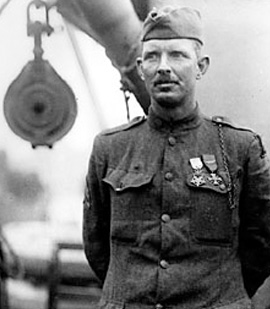Alvin Cullum York
Corporal, U.S. Army, Company G, 328th Infantry, 82d Division. For actions near Chatel-Chehery, France.
October 08, 1918

Born December 13, 1887, Fentress County, TN, York, a pacificst, entered service at Pall Mall, TN. His heroics made him the public face of the Medal of Honor, and one of the most famous people in the world.
York was a simple man of faith, tailor-made to become the public face of American heroism. But he didn’t start out that way. Born to a desperately poor family, York helped his widowed mother raise eight younger siblings and came to East Tennessee for logging and railroad jobs.
A religious conversion on Jan. 1, 1915, led York to change give up his rowdier behavior. His church held no formal pacifist doctrine but shunned all politics and violence. York was shaken by the outbreak of war. "I didn't want to go and kill,” he said. “I believed in my bible." At Camp Gordon, Georgia, York spoke extensively with his commanders, seeking guidance. After a visit home, he returned committed to his role as soldier.
On October 8, 1918, in the Argonne Forest of France, York’s battalion came under heavy fire. York later wrote, “We couldn’t tell for certain where the terrible heavy fire was coming from... I'm telling you they were shooting straight. Our boys just went down like the long grass before the mowing machine.” York and 16 others were sent behind enemy lines to take out machine guns overlooking the American position.
They overran the German headquarters and captured a large group of Germans. While managing the prisoners, more machine gun fire racked the group from a ridge, killing nine and leaving York in charge of the remaining soldiers. Leaving his men under cover to guard the prisoners, York inched his way toward the nest.
“I didn't want to kill any more than I had to. But it was they or I. And I was giving them the best I had,” he said.
When York emptied his rifle, six Germans charged him with bayonets. With his Colt .45 York shot all six before they could reach him. The German officer fired his pistol but failed to injure York and, seeing his losses mount, surrendered. York and seven surviving men captured 35 machine guns and 132 German prisoners.
York’s heroism went unnoticed until journalist George Patullo told his remarkable story to two million readers of the Saturday Evening Post. York received a hero’s welcome throughout the nation. The story of this simple, man, his principles and his talent with firearms, captured the imagination. Offered large sums to make appearances and endorse products, York chose to lend his name only to charitable and civic causes. He formed the Alvin C. York Foundation to expand educational opportunities in Tennessee, established the York Agricultural Institute and raised funds for the Red Cross. He agreed to have his life story published only to raise money for education and turned down several offers to sell his story to the film industry.
Finally, in 1940, to finance a Bible school, he agreed to the film that became Sergeant York and won an Academy Award for Gary Cooper. He has been honored with a postage stamp, buildings named in his honor, including the Alvin C. York Veterans Hospital in Murfreesboro, and a state park. Pulitzer Prize winner Robert Frost used York as the model for characters in two novels, Heaven’s Gate and The Cave, both explorations of the price of peacetime fame for war heroes.

